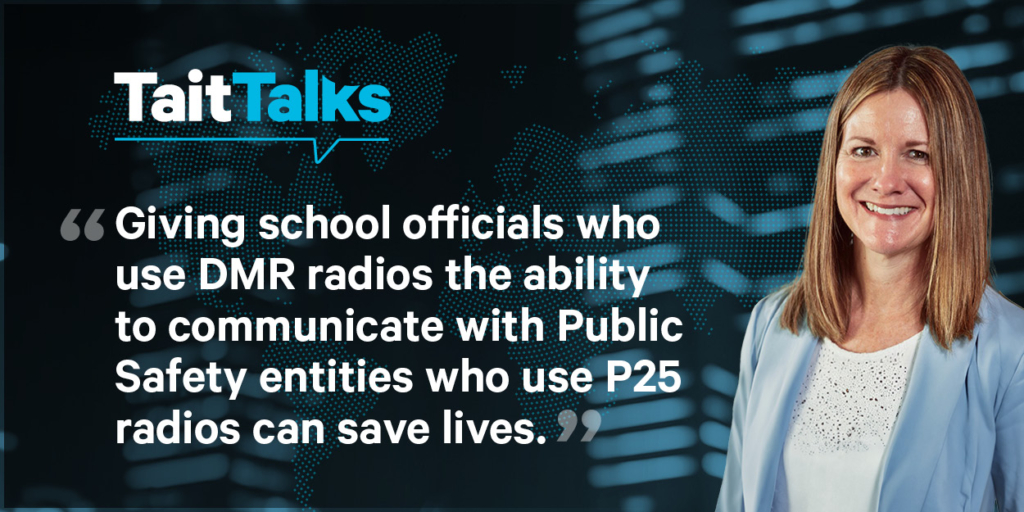Blogs
In this edition of Tait Talks, join Sandra Wendelken, market insights manager, Daniel Draughn, director global solutions, and Anthony Blyth, global product marketing manager, as they take you through the current DMR landscape, alongside talks of multiprotocol P25 solutions.

The Digital Mobile Radio (DMR) standard has taken off in North America and across the world with about 18.5 million global users. At the end of 2022, nearly 4.7 million DMR Tier 2 and Tier 3 radios were installed across North America, according to global market research firm Omdia. The DMR installed base is expected to increase to 5.4 million by 2027, growing at a compound annual growth rate (CAGR) of 6.4%. Estimates put the U.S. installed base of DMR radios at about 4 million at the end of last year with a similar CAGR.
The European Telecommunication Standards Institute (ETSI)-produced DMR standard specifies two-slot TDMA in 12.5 kHz channels operating in frequency bands from 66-960 MHz. DMR Tier 2 covers licensed conventional radio systems, mobiles and portables. DMR Tier 3 covers trunking operation and supports voice and short messaging handling similar to MPT-1327 with built-in 128-character status messaging and short messaging with up to 288 bits of data in a variety of formats.
The DMR Association (DMRA), counting hundreds of DMR equipment manufacturers as members, continues to monitor and update the standard. The most recent DMR standards changes, published in 2021, include updates to the trunking protocol. DMR is a modern and lower-cost alternative digital LMR technology to both P25 and TETRA. Some vendors have focused on DMR for basic business communications, while Tait has implemented DMR with a mission-critical approach for markets where P25 or TETRA does not suit, such as utilities and European fire rescue service agencies. This has led to a diverse array of user groups, including utilities, fire departments, transportation organizations, mines, and oil and gas firms, that have embraced DMR technology for their critical communications needs.
One of the many vertical markets that finds value in DMR technology is the education sector. With school safety top of mind, the nearly 13,000 school districts across the United States in particular, are adding communications equipment to their school safety technology portfolios. LMR networks and DMR specifically can provide the necessary immediate notifications and coverage wherever school employees might need it, from basements to gymnasiums to classrooms.
The number of elementary, secondary, and higher education employees is around 7.9 million in the United States, according to the U.S. Census Bureau. Each of those workers could potentially carry an LMR device to enhance communications for daily tasks, but more importantly during emergency situations. Unfortunately, school shootings continue to plague the United States. During such a horrific event, allowing school employees to have a communications lifeline is essential.
Of course, many public safety officials across the United States take advantage of P25 networks and advancements. Giving school officials who are often using DMR radios the ability to communicate with law enforcement officials, firefighters, or EMS technicians using P25 radios can save lives. Historically, a local police agency using a P25 network has been limited in its ability to communicate directly with an agency operating on a DMR system, such as a local fire department or school district, without special configuration such as a console patch. But interoperable communications between the two different systems could be possible with a multiprotocol DMR and P25 radio, something that has not been commercially available in the market to date.
Tait has become an industry leader in both P25 and DMR, actively contributing to the development of these open standards for almost 20 years. Tait continues to push the boundaries of digital mobile radio technology including the convergence of narrowband and broadband technologies. In 2023, Tait has released the TP9800 multiband P25 radio and the TP9700 world first multiband DMR Tier 2 and Tier 3 radio.
In 2024, Tait will follow with the TP9900, a multiband and multiprotocol P25 and DMR radio. With the Tait multiband and multiprotocol radio, any first responder agency needing interoperability between P25 and DMR can achieve it with a mode change (i.e., switch from P25 to DMR or DMR to P25 with a knob turn) while maintaining exceptional audio and a host of other features. In summary, the TP9900 will bridge the interoperability needs of both P25 and DMR users who need to communicate with each other.
The TP9900 combined with the TB9400 base station, which can be licensed to operate in P25 or DMR mode, reduces the cost of ownership and simplifies maintenance operations. The TB9400 base station’s built-in spectrum analyzer can shorten the time it takes to identify and solve RF interference problems as well.
Tait continues to focus on customer-driven, standards-based functional requirements for both subscribers and infrastructure. Stay tuned for exciting announcements surrounding Tait multiprotocol products in the months to come.
Written by: Sandra Wendelken – Market Insights Manager at Tait Communications.















